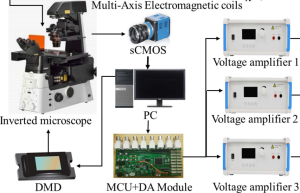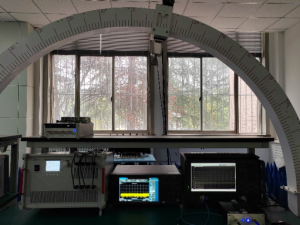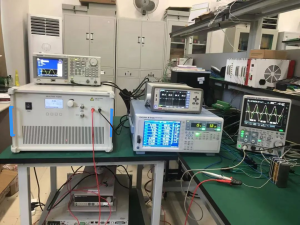Electromagnetic Testing
As a key pillar of modern science and technology, electromagnetic testing research is of multifaceted significance and importance, profoundly impacting scientific and technological development, social security, and industrial upgrading. It is a core component in ensuring the stable operation of electronic information systems.
Power amplifiers, as a crucial component of electromagnetic testing systems, offer excellent bandwidth and linearity, providing sufficient excitation signals for electromagnetic testing and playing an indispensable role in electromagnetic testing research.
Experimental Case
1. Application of Power Amplifiers in Motion Control of a Photopolymerization Magnetic Robot

In this experiment, three SLA-HV-400D high-power amplifiers were connected to the output of a microcontroller chip and the five coils of an electromagnetic coil system under an inverted microscope. Commands sent by a host computer were amplified by the amplifiers to a specific factor, enabling control of the electromagnetic coil system. The electromagnetic coils generated a multimodal magnetic field to control the motion of the photopolymerization robot.
2. Application of Power Amplifiers in Generating Time-Modulated Sequences in Electromagnetic Materials

In this experiment, a square wave signal generated by an arbitrary signal generator is used to generate a control voltage signal through a power amplifier based on a time-coded sequence. This voltage signal controls the operating state of the diode in the electromagnetic material, achieving dynamic control of electromagnetic wave radiation and scattering.
3. Application of Power Amplifiers in Drug Delivery Using Magnetic Soft Microrobots
In this experiment, a fish-like soft robot is designed that can swim freely in three dimensions in a confined, unstructured liquid environment. Driven by a magnetic field, this robot can mimic the swimming behavior and locomotion of fish, potentially providing innovative diagnostic and therapeutic tools for targeted in vivo therapy.
4. Application of High-Voltage Power Amplifiers in Measuring High-Frequency Core Loss
In this experiment, the core loss of a toroidal magnetic core is measured under sinusoidal and PWM excitation with frequencies ranging from 50 kHz to 500 kHz and magnetic flux density amplitudes ranging from 0 to 0.2 T. The required waveform is generated by a signal generator, and then the signal is input into the primary side of the core using a power amplifier. The core loss inside the toroidal core is measured using the double-winding method.
5. Application of an Underwater Acoustic Power Amplifier in the Design of a Breathable Magnetic Core Based on Vector Magnetic Circuit Theory

This experiment aims to calculate the reluctance and induction of a breathable magnetic core. Three sets of cores with different aperture diameters were fabricated. Two cores were assembled to form a closed magnetic circuit. Both the primary and secondary windings were wound around the center column. Three measurement points were set along the closed magnetic circuit to monitor the core temperature during the experiment.



